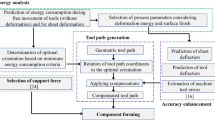Abstract
Single Point Incremental Forming (SPIF) is a die-less forming process that can be economically used for low volume production of sheet metal components. One of the limitations of SPIF is the maximum wall angle that can be formed in a single stage. To overcome this limitation, Multi-stage Single Point Incremental Forming (MSPIF) is used to form components with large wall angles. When the tool is moved from out-to-in during any stage, material present ahead of it (towards the centre of the component) moves down rigidly. If this rigid body displacement is not considered during tool path generation for MSPIF, it leads to stepped/unwanted features. Predicting the component geometry after each stage helps in monitoring the shape being developed and in turn is useful in designing intermediate stages to form required final geometry with desired accuracy. In the present work, a simple methodology is proposed to predict rigid body displacement based on tool path and process parameters (tool diameter, incremental depth, sheet thickness) used. Tool and sheet deflections due to forming force are also considered to predict final geometry of the component. Proposed methodology is validated by comparing predicted profiles with experimentally measured profiles of high wall angle axisymmetric components formed using different materials and sheet thicknesses. Predicted profiles are in good agreement with experimental results.














Similar content being viewed by others
References
Jeswiet J, Micari F, Hirt G, Bramley A, Duflou A, Allwood J (2005) Asymmetric single point incremental forming of sheet metal. CIRP Ann Manuf Technol 54(2):623–649
Cao J, Huang Y, Reddy NV, Malhotra R, Wang Y (2008) Incremental sheet metal forming: advances and challenges. Proceedings of 9th ICTP: pp. 751
Reddy NV, Lingam R, Cao J (2014) Incremental sheet metal forming processes. In Nee AYC (ed) Handbook of manufacturing engineering and technology, Springer
Hirt G, Ames J, Bambach M, Kopp R (2004) Forming strategies and process modeling for CNC incremental sheet forming. CIRP Ann Manuf Technol 53(1):203–206
Duflou JR, Verbert J, Belkassem B, Gu J, Sol H, Henrard C, Habraken AM (2008) Process window enhancement for single point incremental forming through multi-step toolpaths. CIRP Ann Manuf Technol 57(1):253–256
Skjoedt M, Bay N, Endelt B, Ingarao G (2008) Multi stage strategies for single point incremental forming of a cup. Int J Mater Form 1(1):1199–1202
Skjoedt M, Silva MB, Martins PFA, Bay N (2010) Strategies and limits in multi-stage single point incremental forming. J Strain Anal Eng Des 45(1):33–44
Abhishek K (2009) Multi-stage tool path strategies for single point incremental forming. M.Tech thesis, Indian Institute of Technology Kanpur
Malhotra R, Bhattacharya A, Kumar A, Reddy NV, Cao J (2011) A new methodology for multi-pass single point incremental forming with mixed tool paths. CIRP Ann Manuf Technol 60(1):323–326
Kim TJ, Yang DY (2000) Improvement of formability for the incremental sheet metal forming process. J Mech Sci 42(7):1271–1286
Young D, Jeswiet J (2004) Wall thickness variations in single-point incremental forming. Proc Inst Mech Eng B J Eng Manuf 218(11):1453–1459
Yu TX, Zhang LC (1996) Plastic bending: theory and applications. World scientific
Xu D, Malhotra R, Reddy NV, Chen J, Cao J (2012) Analytical prediction of stepped feature generation in multi-pass single point incremental forming. J Manuf Process 14(4):487–494
Asghar J, Lingam R, Shibin E, Reddy NV (2014) Tool path design for enhancement of accuracy in single-point incremental forming. Proc Inst Mech Eng B J Eng Manuf 228(9):1027–1035
Bhattacharya A, Maneesh K, Reddy NV, Cao J (2011) Formability and surface finish studies in single point incremental forming. J Manuf Sci Eng 133(6):061020
Silva MB, Skjoedt M, Atkins AG, Bay N, Martins PAF (2008) Single-point incremental forming and formability-failure diagrams. J Strain Anal Eng Des 43(1):15–35
Adams D, Jeswiet J (2014) A new model for contact geometry in single-point incremental forming. Proc Inst Mech Eng B J Eng Manuf. doi:10.1177/0954405414535580
Aerens R, Eyckens P, Van Vael A, Duflou A (2010) Force prediction for single point incremental forming deduced from experimental and FEM observations. Int J Adv Manuf Technol 46(9–12):969–982
Timoshenko S (1964) Theory of plates and shells, 2nd edn. McGraw-Hill, New York
Author information
Authors and Affiliations
Corresponding author
Appendix A. Rigid body displacement prediction proposed by Malhotra et al. [9] and Xu et al. [13]
Appendix A. Rigid body displacement prediction proposed by Malhotra et al. [9] and Xu et al. [13]
In this model the rigid body displacement for OI pass is given by:
where ∆y is the distance between contact point in n + 1th stage and its projection on to the profile after nth stage (Fig. 14b), L is the length of profile in nth stage from the projected point to the base (Fig. 14a), γ is a constant calibrated using FEA, K (R), E (R) are the complete elliptic integrals of first and second kind respectively and F (φ 0, R), E (φ 0, R) are the incomplete elliptic integrals of first and second kind respectively, φ 0, R are the functions of θ 1 , θ 2 , S where θ 2 is the wall angle at the contact point in n + 1th stage, θ 1 is the wall angle at the projection of contact pint on to the nth stage profile (Fig. 14b) and S is the distance from component opening to the contact point along n + 1th profile (Fig. 14b).
Rights and permissions
About this article
Cite this article
Lingam, R., Bansal, A. & Reddy, N.V. Analytical prediction of formed geometry in multi-stage single point incremental forming. Int J Mater Form 9, 395–404 (2016). https://doi.org/10.1007/s12289-015-1226-y
Received:
Accepted:
Published:
Issue Date:
DOI: https://doi.org/10.1007/s12289-015-1226-y




